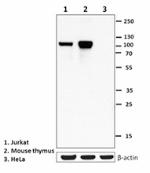- Clone
- O96C6 (See other available formats)
- Regulatory Status
- RUO
- Other Names
- Special AT-rich sequence-binding protein 1, SATB homeobox 1, DNA-binding protein SATB1
- Isotype
- Mouse IgG1, κ
- Ave. Rating
- Submit a Review
- Product Citations
- publications

-

Jurkat cells were fixed with 1% paraformaldehyde (PFA) for ten minutes and then were permeabilized with 0.5% Triton X-100 for five minutes followed by blocking with 5% FBS for 30 minutes. The cells were then intracellularly stained with 2.5 µg/ml Alexa Fluor® 594 anti-SATB1 antibody (clone O96C6, red) in blocking buffer overnight at 4°C. Nuclei were counterstained with DAPI (blue).
| Cat # | Size | Price | Quantity Check Availability | Save | ||
|---|---|---|---|---|---|---|
| 676104 | 100 µg | 370 CHF | ||||
SATB1 is a global regulator that selectively tethers multiple genomic loci and recruits chromatin-remodeling enzymes (e.g. ACF, ISWI, HDAC1 and histone acetyltransferase) to control chromatin structure and gene expression. SATB1 also recruits corepressors or coactivators to promoters. These two opposing interactions, however, are determined by whether or not the SATB1 is phosphorylated by protein kinase C. Unphosphorylated and phosphorylated SATB1 preferably binds to PCAF and HDAC1, respectively. SATB1 also forms a regulatory complex with the promyelocytic leukaemia (PML) protein to organize the major histocompatibility complex (MHC) class I locus into distinct chromatin-loop architecture and mediate the expression of a subset of MHC class I genes. Upon Th2 cell activation, SATB1 expression is induced to compact chromatin into dense-loop structure and to prompt the expression of IL-4, IL-5, IL-13 and c-Maf. SATB1 is also reported as being crucial for the growth and metastasis of breast cancer and is a potential prognostic marker.
Product DetailsProduct Details
- Verified Reactivity
- Human, Mouse
- Antibody Type
- Monoclonal
- Host Species
- Mouse
- Immunogen
- Full length recombinant human SATB1 (NP_002962) produced in HEK293T cells.
- Formulation
- Phosphate-buffered solution, pH 7.2, containing 0.09% sodium azide.
- Preparation
- The antibody was purified by affinity chromatography and conjugated with Alexa Fluor® 594 under optimal conditions.
- Concentration
- 0.5 mg/ml
- Storage & Handling
- The antibody solution should be stored undiluted between 2°C and 8°C, and protected from prolonged exposure to light. Do not freeze.
- Application
-
ICC - Quality tested
- Recommended Usage
-
Each lot of this antibody is quality control tested by immunocytochemistry. For immunocytochemistry, a concentration range of 0.1 - 10 μg/ml is recommended. It is recommended that the reagent be titrated for optimal performance for each application.
* Alexa Fluor® 594 has an excitation maximum of 590 nm, and a maximum emission of 617 nm.
Alexa Fluor® and Pacific Blue™ are trademarks of Life Technologies Corporation.
View full statement regarding label licenses - RRID
-
AB_2566180 (BioLegend Cat. No. 676104)
Antigen Details
- Structure
- Homodimer. Canonical sequence contains 763 amino acids, predicted molecular weight of 86 kD. Isoform contains 795 amino acids, predicted molecular weight of 89 kD.
- Distribution
-
Nucleus matrix. Nucleus. Promyelocytic leukemia nuclear bodies (SUMOylated).
- Function
- SATB1 recruits chromatin remodeling factors to regulate chromatin-loop structure and gene transcription. It is an important silencing factor for initiating the Xist RNA-mediated X inactivation in mammals.
- Interaction
- CUX1, CtBP1, PCAF, SUMOylated PML, HDAC1 and HIV-1 Tat, DYNLT2, POLR2J2, EP300, special AT-rich DNA sequences (consensus SATB1-binding sequence, CSBS).
- Biology Area
- Cell Biology, Immunology, Transcription Factors
- Antigen References
-
1. Agrelo R, et al. 2009. Dev. Cell. 16:507.
2. Han HJ, et al. 2008. Nature. 452:187.
3. Cai S, et al. 2006. Nature Genet. 38:1278.
4. Pavan Kumar, P, et al. 2006. Mol. Cell. 22:231.
5. Fujii Y, et al. 2003. Microbiol. Immunol. 47:803.
6. Yasui, D, et al. 2002. Nature. 419:641. - Gene ID
- 6304 View all products for this Gene ID
- UniProt
- View information about SATB1 on UniProt.org
Related Pages & Pathways
Pages
Other Formats
View All SATB1 Reagents Request Custom Conjugation| Description | Clone | Applications |
|---|---|---|
| Purified anti-SATB1 | O96C6 | WB,ICC |
| Alexa Fluor® 594 anti-SATB1 | O96C6 | ICC |
Compare Data Across All Formats
This data display is provided for general comparisons between formats.
Your actual data may vary due to variations in samples, target cells, instruments and their settings, staining conditions, and other factors.
If you need assistance with selecting the best format contact our expert technical support team.
-
Purified anti-SATB1

Jurkat cells were stained with purified anti-SATB1 (clone O9... 
Total cell lysate from Jurkat (lane 1, 15 µg), mouse thymus ... -
Alexa Fluor® 594 anti-SATB1

Jurkat cells were fixed with 1% paraformaldehyde (PFA) for t...
 Login / Register
Login / Register 













Follow Us